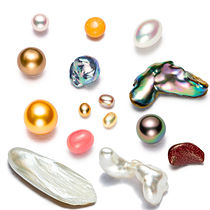Pearls
| Pearl | |
|---|---|

Various pearls
|
|
| General | |
| Category | Mineral |
|
Formula (repeating unit) |
CaCO3 |
| Identification | |
| Color | white, pink, silver, cream, brown, green, blue, black, yellow, and purple |
| Cleavage | none |
| Mohs scale hardness | 2.5–4.5 |
| Streak | white |
| Specific gravity | 2.60–2.85 |
| Dispersion | none |
| Ultraviolet fluorescence | weak, cannot be evaluated. Genuine black p .: Red to reddish River-p.: Strong: pale green |
A pearl is a hard object produced within the soft tissue (specifically the mantle) of a living shelled mollusk. Just like the shell of a clam, a pearl is composed of calcium carbonate in minute crystalline form, which has been deposited in concentric layers. The ideal pearl is perfectly round and smooth, but many other shapes, known as baroque pearls, can occur. The finest quality natural pearls have been highly valued as gemstones and objects of beauty for many centuries. Because of this, pearl has become a metaphor for something rare, fine, admirable and valuable.
The most valuable pearls occur spontaneously in the wild, but are extremely rare. These wild pearls are referred to as natural pearls. Cultured or farmed pearls from pearl oysters and freshwater mussels make up the majority of those currently sold. Imitation pearls are also widely sold in inexpensive jewelry, but the quality of their iridescence is usually very poor and is easily distinguished from that of genuine pearls. Pearls have been harvested and cultivated primarily for use in jewelry, but in the past were also used to adorn clothing. They have also been crushed and used in cosmetics, medicines and paint formulations.
Whether wild or cultured, gem-quality pearls are almost always nacreous and , like the interior of the shell that produces them. However, almost all species of shelled mollusks are capable of producing pearls (technically "calcareous concretions") of lesser shine or less spherical shape. Although these may also be legitimately referred to as "pearls" by gemological labs and also under U.S. Federal Trade Commission rules, and are formed in the same way, most of them have no value except as curiosities.
The English word pearl comes from the French perle, originally from the Latin perna meaning leg, after the ham- or mutton leg-shaped bivalve.
...
Wikipedia
